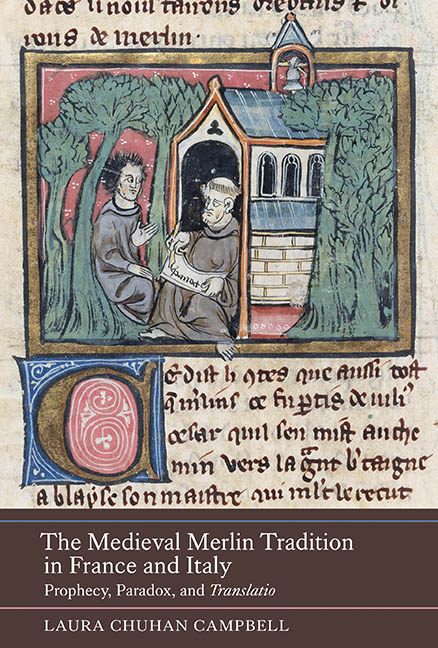Book contents
- Frontmatter
- Contents
- Miscellaneous Frontmatter
- Acknowledgements
- List of Abbreviations
- Introduction
- 1 Sympathy for a Devil? Merlin's Conception according to Robert de Boron and Paulino Pieri
- 2 Death of the Author: Merlin's Imprisonment by the Dame du Lac
- 3 Beyond the Limits of Interpretation: Rewriting Prophetic Discourse in the Estoire de Merlin and the Suite du Merlin
- 4 ‘Ce dit Merlin’: Open and Closed Prophecies in the Italian Merlin Tradition
- Conclusion
- Appendix 1 Chronology of Primary Texts
- Appendix 2 Summaries of the Principal Texts Discussed
- Bibliography
- Index
- Miscellaneous Endmatter
Introduction
Published online by Cambridge University Press: 23 August 2019
- Frontmatter
- Contents
- Miscellaneous Frontmatter
- Acknowledgements
- List of Abbreviations
- Introduction
- 1 Sympathy for a Devil? Merlin's Conception according to Robert de Boron and Paulino Pieri
- 2 Death of the Author: Merlin's Imprisonment by the Dame du Lac
- 3 Beyond the Limits of Interpretation: Rewriting Prophetic Discourse in the Estoire de Merlin and the Suite du Merlin
- 4 ‘Ce dit Merlin’: Open and Closed Prophecies in the Italian Merlin Tradition
- Conclusion
- Appendix 1 Chronology of Primary Texts
- Appendix 2 Summaries of the Principal Texts Discussed
- Bibliography
- Index
- Miscellaneous Endmatter
Summary
Merlin owes much of his literary success to French prose writers of the early thirteenth century. It was they who first brought him from Latin history into vernacular romance, and who endowed his already enigmatic character with a compelling origin story and a doomed romance. The Arthurian stories in which he featured quickly gained popularity throughout the major literary centres of Western Europe, as a result of both the prolific production and wide circulation of Francophone literature in this period. As advisor to Uther and Arthur, founder of the Round Table, and herald of the grail, Merlin is central to the Arthurian story; however, his reputation as an omniscient prophet has allowed him to transcend the context of vernacular romance and take on a textual life that is independent of the Arthurian universe. Nowhere is this more evident than in Merlin's transition from French to Italian literature, through which he became a symbol of political resistance to imperial domination and ecclesiastical corruption in the north of the peninsula. This book will examine the rewriting of Merlin in French, Franco-Italian, and Italian vernacular texts, foregrounding a direction of transmission that has rarely been considered in previous Merlin scholarship. The story of Merlin's movement from French to Italian is a story of translation, but one that will allow us to question the limits of what translation meant in the Middle Ages. It is a story of prophecy – or rather, a story of why prophecy can never be fully understood. It is a study of a figure who is subject to human limitations, but who, at the same time, transcends those limitations, and whose status on the margins of language, culture, and text personifies the transmission between them.
The Storia di Merlino, written in Florence around 1324 by Paulino Pieri, offers an account of how the story of Merlin and his book of prophecies found its way into French, then into Italian literature. He explains that the book composed by Merlin himself would be translated by a Maestro Riccardo, at the behest of Frederick II, Holy Roman emperor, whose court was based in Sicily.
- Type
- Chapter
- Information
- The Medieval Merlin Tradition in France and ItalyProphecy, Paradox, and Translatio, pp. 1 - 26Publisher: Boydell & BrewerPrint publication year: 2017

